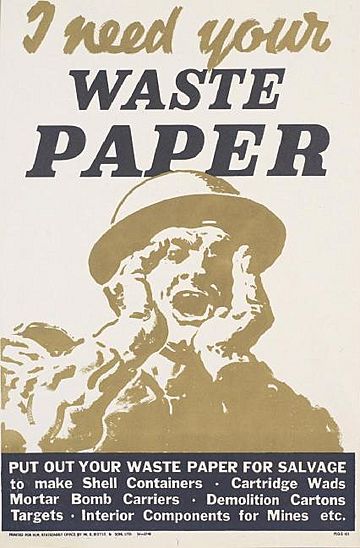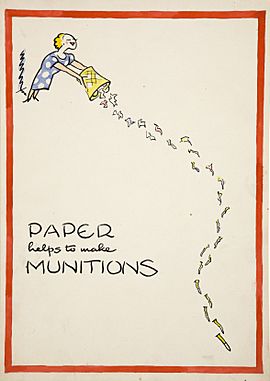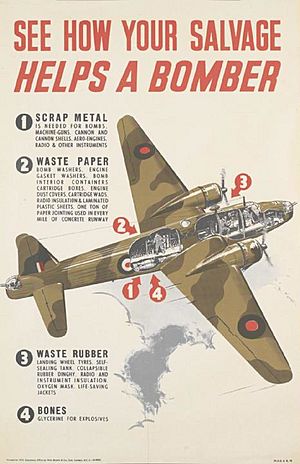Paper Salvage 1939–50 facts for kids
Paper Salvage was a special program in Britain during and after World War II. It started in 1939. The main idea was to encourage everyone to recycle materials. This was super important to help the country during the war. The program continued until 1950.
Contents
Why Paper Salvage Was Important
During World War II, Britain needed many resources. Importing materials was difficult. So, the government asked people to recycle things. This was called "salvage." Paper salvage was a big part of this effort. It was similar to the "Salvage for Victory" campaign in America.
The idea came from experiences in the First World War. Back then, prices for materials went up a lot. This was because it was hard to get things from other countries. To avoid this problem, a special department was set up. It was part of the Ministry of Supply in November 1939. A "Salvage Controller" was put in charge.
At first, the government just asked people to help. Local councils had to report how much they collected. Housewives were encouraged to sort their waste paper.
How Paper Salvage Became Law
As the war went on, the rules became stricter. By late 1940, recycling paper became compulsory. This applied to towns with more than 10,000 people. A year later, it included smaller towns too. This meant about 43 million people were covered. From 1942, there were serious penalties for not sorting waste.
Many people helped with the program. Over a hundred thousand volunteer "salvage stewards" worked locally. They ran collection points and encouraged sorting. Even the royal family got involved. Queen Elizabeth (who later became the Queen Mother) asked housewives to follow her example.
Paper Salvage After the War
The program continued even after the war ended. This helped Britain get back to normal life. After an economic problem in 1947, efforts increased. Newspaper ads explained how important saving paper was. For example, one ton of saved paper could make 2,956,800 cigarettes. It could also make 12,000 square feet of ceiling board. Or 17,000 sheets of brown wrapping paper. It could even make 201,600 books of matches!
Protecting Old Records
Not everyone wanted all paper to be recycled. The British Records Association was worried. They feared that important historical documents might be thrown away. So, they started their own small campaign. They wanted to protect valuable old records. They used the slogan "Look before you throw." By the end of 1943, they had given out 33,000 leaflets.
Results of Paper Salvage
Before the war, Britain collected less than 1,000 tons of scrap paper each week. By 1940, local councils collected 248,851 tons a year. This was a big increase. The collection peaked in 1942, reaching 433,405 tons. At this point, 60 percent of all new paper came from recycled sources.
After the war, collection figures dropped. But they rose again in 1948 to 311,577 tons. The price of scrap paper was set at about £5 a ton. This was much higher than before the war. This program added between £3 million and £5 million to the economy.
However, the government's interest in the program changed. Especially after 1947. The compulsory rules ended on June 30, 1949. The special offices for paper control closed down. By April 1950, price controls also ended. After this, the paper salvage program slowly faded away. British paper mills then started to import waste paper from other countries.




